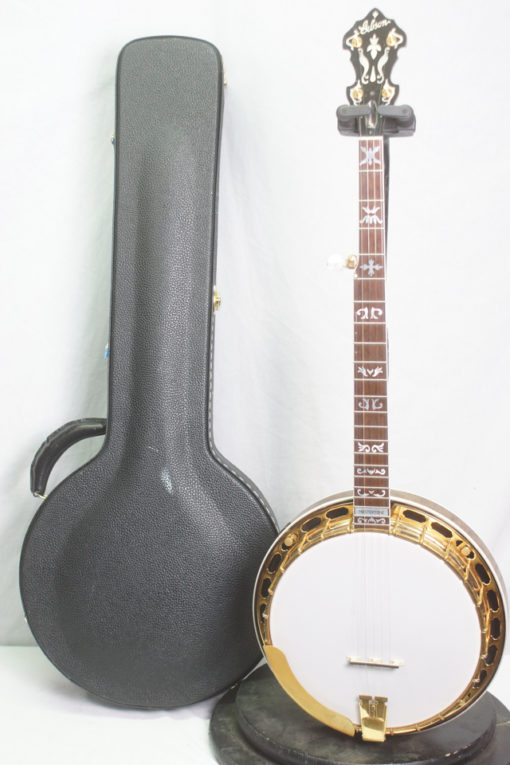

- GIBSON MASTERTONE BANJO SERIAL NUMBERS SERIAL NUMBERS
- GIBSON MASTERTONE BANJO SERIAL NUMBERS SERIAL NUMBER
I have also done the job by hand with a piece of sand paper attached to the waste cut off the heel of the neck. This also allows us to adjust our radius and angle a little bit. After cutting the banjo neck heel radius with the band saw a sanding wheel jig may be used to get all the saw marks off the heel of the neck. This jig can be made from wood or it could be made from metal. On the side of the plate that has the concave arc there should be a wedge that will hold the neck at 3 degrees from the plane of the plate. The arc should have a diameter a tiny bit less than the diameter of the rim you intend to use. The plate of the jig has two halves, one half has a convex arc and the other has a concave arc.

It consists of a plate that screws or clamps onto the saw table of a band saw. It helps cut an angle and a radius at the same time.

The banjo neck heel radius jig is used to assist in cutting the heel of the neck so that it will mate cleanly with the rim. Not only should it be angled but it also must have a radius that is cut at the proper angle to fit the hoop and deliver the desired playability. It is structurally and acoustically important that this joint have a good fit. My favorite banjos have a neck angle of 3 degrees.Ĭutting the banjo neck heel radius is complicated because the neck will be attached to a round hoop. Too flat an angle is not so good either as it may render the instrument dull.įiddles often have a neck angle of seven degrees, many flat top guitars have only one degree of neck angle. The sharper the angle of the string across the bridge the more downward pressure is communicated to the head. It also increases the angle of the strings across the bridge. This small angle allows for adjustment to take place. Nearly all stringed instruments have the neck attached at an angle. L-Shoe Bracket.The banjo neck heel radius is a subtle detail that makes all the difference. By: Sachiko Schott Updated September 15, Banjo Picking image by Tequila Photography from Fotolia. The prewar Gibson Mastertone banjo is the rarest and most valuable model of Gibson banjo, so it is the most likely to be faked. Even if your banjo doesn't match the description of a Gibson exactly, it may still be one. There are many styles of Gibson banjos, and there is a lot of variation within those styles. Knowing if your Gibson banjo is a prewar or postwar model will help you understand the serial number.
GIBSON MASTERTONE BANJO SERIAL NUMBERS SERIAL NUMBERS
The numbering system used by Gibson to choose their serial numbers was counterintuitive during their prewar period. These lists will tell you what year your banjo was manufactured and what style it is.

Go to the official Gibson website or check a list of Gibson serial numbers see Resources.
GIBSON MASTERTONE BANJO SERIAL NUMBERS SERIAL NUMBER
You may see the serial number stamped into the wooden rim of the banjo's body or written inside the resonator in chalk.Ĭheck that the configuration of the serial number is right for the time period. The screws are large enough that you can do this with your fingers, and a screwdriver won't be necessary. Loosen the screws attaching the back to the banjo. Remove the back of your banjo-the resonator-to see the serial number if it isn't on the back of the peghead. A serial number is an important piece of information in establishing the authenticity of your banjo. Look for the serial number on the back of the peghead. If it isn't a Mastertone, the oval decal will be smaller and will have "The Gibson" written in script, with "Gibson Inc. If your banjo is a Gibson Mastertone, "Gibson Mastertone" is written at the top of the decal. Look for a Gibson decal on the inside of the wooden rim that forms the body of the banjo. Any instrument with script lettering was made before and is called a "prewar" model, while block letters indicate a "postwar" model. InGibson changed the logo on all their instruments from script lettering to block letters. Examine the Gibson logo on the peghead, the part of the banjo where the tuning pegs attach. Gibson banjos carry decals, serial numbers and other physical features that can help you learn more about your banjo. The Gibson Guitar Corporation manufactures both acoustic and electrical instruments, including banjos.


 0 kommentar(er)
0 kommentar(er)
